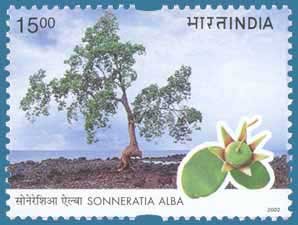Mangrove Apple (Sonneratia alba)

Technical Data
| Stamp Set | UN Conference on Climate Change, New Delhi |
|---|---|
| Date of Issue | October 30, 2002 |
| Denomination | Rs. 15 |
| Quantity | 3,000,000 |
| Perforation | Syncopated 13 x 13¼ |
| Printer | Calcutta Security Printers Ltd |
| Watermark | No Watermark |
| Colors | Multicolor |
| Catalog Codes |
Michel IN 1927 Stamp Number IN 1978 Yvert et Tellier IN 1692 Stanley Gibbons IN 2093 WADP Numbering System - WNS IN038.02 |
| Themes | Conferences | Flowers | Landscapes | Plants (Flora) | Trees | U.N.O. |
Table of Contents
Mangrove Apple (Sonneratia alba)
Overview
- Scientific Name: Sonneratia alba
- Common Name: Mangrove Apple
- Family: Sonneratiaceae
Description
- Appearance: Sonneratia alba is a mangrove tree with a distinctive appearance due to its large, prominent roots and thick, waxy leaves.
- Leaves: The leaves are simple, ovate to elliptical, and typically 10 to 15 cm long. They have a leathery texture and are green on the upper side with a lighter, often silvery appearance on the underside.
- Flowers: The flowers are large and showy, with a tubular, white to pale pink structure and numerous long, protruding stamens. They are usually found in clusters and bloom in the summer.
- Fruits: The fruit is a cylindrical, fleshy structure that resembles an apple, hence the common name. It is often green when immature and turns brown or reddish as it ripens. The fruit contains numerous seeds adapted for water dispersal.
Habitat
- Distribution: Sonneratia alba is found in the mangrove forests of tropical and subtropical regions, particularly in Southeast Asia, Northern Australia, and the islands of the Pacific Ocean.
- Environment: This species thrives in saline, brackish, and intertidal zones of mangrove swamps and estuaries. It is well adapted to the harsh conditions of mangrove habitats, including high salinity and waterlogged soils.
Ecological Importance
- Coastal Protection: The tree’s extensive root system helps stabilize coastal sediments, reducing erosion and protecting shorelines from the impacts of storm surges and tidal flooding.
- Habitat: Sonneratia alba provides critical habitat for various wildlife species, including fish, birds, and insects. Its fruits and flowers attract a range of animals, contributing to the biodiversity of the mangrove ecosystem.
- Nutrient Cycling: The decomposition of fallen leaves and fruits adds organic matter to the mangrove soil, supporting nutrient cycling and the overall health of the mangrove forest.
Conservation Status
- Threats: Sonneratia alba faces threats from habitat destruction due to coastal development, pollution, and climate change. These factors can lead to the degradation of mangrove ecosystems and loss of biodiversity.
- Conservation Efforts: Conservation strategies include protecting mangrove habitats from development, promoting sustainable land use practices, and supporting reforestation projects to restore degraded areas.
Cultural and Economic Value
- Traditional Uses: The tree’s wood is used for construction and fuel in some regions. The fruit, though not commonly consumed, is sometimes used in traditional medicine.
- Economic Value: By contributing to coastal protection and supporting fisheries, Sonneratia alba plays a role in the livelihoods of coastal communities. Its presence in mangrove ecosystems helps maintain the ecological balance that benefits local economies.
Stamp Design
The stamp featuring Sonneratia alba highlights the distinctive characteristics of the Mangrove Apple, including its large, fleshy fruit and prominent root system. The design emphasizes the ecological significance of the species in maintaining healthy mangrove ecosystems and aims to raise awareness about the importance of conserving these vital coastal habitats.
